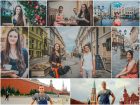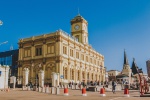The off the beaten path is not too hard to find when you are in Moscow. It’s just 1-2 km away from Red Square which is a #1 of all things to do in Moscow.
Get in the spirit of ancient times in the oldest neighborhood of Moscow – Zamoskvorechye – and start your Off The Beaten Path tour in Moscow right from Red Square.

Panoramic view of Moscow from Centralny Detsky Mir
- The district Zamoskvorechye or Beyond-the-Moskva-river district is our favorite off the beaten path in Moscow. The area has its very own elegance and charm despite the fact that it suffered from numerous floods in the 16th century. The names of streets in this area still remind us of that: Bolotnaya square can be translated as “mud square”.
- The street Ordynka marks the way used by Tatar-Mongols when they invaded Russian principalities. In the Russian language their hostile troops were called “Orda” hence the name of the street – Ordynka.
- Tatar-Mongolian embassies used to settle down along the street Ordynka. This tradition can be tracked from the 16th century as a number of embassies of different countries (e.g. Israel, Kenya) are located along this street.
- The main square of the district – Bolotnaya square – was used for executions, and a famous riot leader Pugachev was executed there.
- In the Soviet period in Moscow there was a tendency to build houses and give apartments to people of the same profession. In the Zamoskvorechye district there is the House of Writers, which was mentioned in a famous dramatic novel “Master and Margarita” by a Russian writer Mikhail Bulgakov.
- In the novel Margarita (as a witch) comes to an apartment of critic Latunsky (who was copied from real critic Litovsky who criticized Bulgakov before), and destroys it. That’s how Bulgakov expressed his displeasure with the critic’s opinion.
- One of the greatest poets of the Soviet time Boris Pasternak lived in this house. His apartment had a direct exit to the roof where he loved watching fireworks and attacks by German pilots.
- There are many legends about Zamoskvorechye and its residents. For example, there is a legend why Russian people used to eat a piglet for Christmas: a piglet is said to have been screaming too loud when Jesus was born and that is why it is being eaten every Christmas. Weird legend, but as it is. Here are not less surprising 31 facts about Russians.
- As for caviar, it has always been a luxurious product for the ancient Greek and Romans. But it has always been quite common in Russia. In the 15th century caviar was the main dish of the Tsar’s palace. In the 16th caviar was the main motive power of the Russian foreign commerce. In the 18th century it was successfully being sold to the Persian. Red caviar could be found in houses of common Muscovites, but the black one was for elite. Check out Correa’s restaurant at Bolshaya Ordynka 40 for pizza with smoked salmon, sour cream and caviar that will add up to your sightseeing experience. If you are a foodie like us, check the best restaurants in Moscow.
- Pavel Tretyakov, a founder of the world famous Tretyakov gallery (10 Lavrushinsky lane), was very shy. When it was the moment to propose to his beloved woman he said instead: “Would you prefer us living with Mom or without her? They lived happily ever after though”.
- In the XIX century Pavel Tretyakov was an influential picture-hunter. It was very honorable to paint a picture that he would choose for his collection. However, very soon it became ambiguous in that sense that painters followed all his directions and lost their personal vision of the picture.
- The famous painting by Repin “Ivan the Terrible is killing his son” was first forbidden to exhibit, which brought even more interest towards the painting.
- A Persian carpet was laid right in front of the painting as an extension of the carpet painted, which made the impression even more realistic.
- In 1913 the painting was damaged by an icon-painter, who cut the cloth with his knife shouting “enough of blood!”
- Great Russian poetess Marina Tsvetaeva rented a house on Ordynka str because it looked like the house she spent her childhood in. She and her husband had to leave this house and it was rented by neuropsychiatrists, which literally turned out to be a madhouse. Tsvetaeva refused to come back to this house again.
- People who now clean streets were treated differently a couple of centuries ago. These were highly respected people, they guarded houses and the residents always made friends with them. Even in some pre-revolutionary pictures you can see street cleaners because they were considered as symbol of the house and people loved having them next to themselves in photos.

Panoramic view of Moscow from Centralny Detsky Mir
- Houses in Zamoskvorechye are built the following way: the ground floor is made of stone and the first floor is made of wood. On the ground floor there was usually a small shop and stone walls that functioned as a fridge; shop owners usually lived on the warmer first floor.
- Martha-and-Mary convent at 34 Bolshaya Ordynka was founded by Grand Duchess Elizabeth Fedorovna (sister of the last empress of Russia Alexandra Fedorovna) when her husband was assaulted by a terrorist. She erected a monument on the site and decided to found an orphanage.
- The architect of the Convent of SS Martha and Mary – Alexey Shchusev – later built Kasan railway terminal in Moscow, as well as Hotel Moskva (present Four Seasons Hotel) and Lenin Mausoleum.
- The Grand Duchess was also one of the nuns in the Convent. She contributed a lot to the development of the orphanage, but along with the Emperor’s family was killed by Bolsheviks.
- After the Revolution in 1917 the Patriarchate was reestablished, and the first Soviet time patriarch was patriarch Tikhon. At that time people praised patriarch more than governmental leaders.
- During the early Soviet years one of the most sacred places in Moscow – Donskoy convent – was turned into… crematory. Great poet of that time Mayakovsky was buried that way…
- Shukhov radio tower is a masterpiece. And though it’s not considered the best architecture of Moscow, it’s still called Eiffel Tower by locals. The 160-metre-high free-standing steel diagrid tower was built in 1920s and is also known as the Shabolovka tower (8 Shukhova str).
- Vladimir Lenin ordered to construct Shukhov Tower because he was sure that Soviet radio programs were intercepted by foreign spies. His idea was to construct a tower which would be powerful enough to interrupt all interceptions.
- Initially the project of the tower consisted of 3 towers, each of them 350 meters high. But the architect Shukhov suggested a more budget option – one tower, 148m high. His suggestion was accepted. The country used every possibility to save as it was an industrial period in the country.
- Shukhov invented the tower’s form accidentally: he “recognized” the future tower in his basket for fruits, when he once saw it turned upside-down.
- On the territory of Donskoy convent you can find original medallions that had been taken from the Cathedral of Christ the Savior before it was destroyed in 1931-1932.
Most Popular Posts
 50 Facts about Moscow – all you need to know about Russian Capital
50 Facts about Moscow – all you need to know about Russian CapitalEverybody likes fun facts and we always prepare a ton of them for our Moscow tours ...
48.1k views
 50 Fun Facts about Los Angeles
50 Fun Facts about Los AngelesA visit to Los Angeles isn’t complete without Hollywood. And Getty Museum. And Downtown LA ...
38.2k views
 50 Facts about Paris
50 Facts about ParisEiffel Tower, Notre Dame de Paris, Louvre, the smell of coffee and freshly baked croissants ...
31.9k views


